
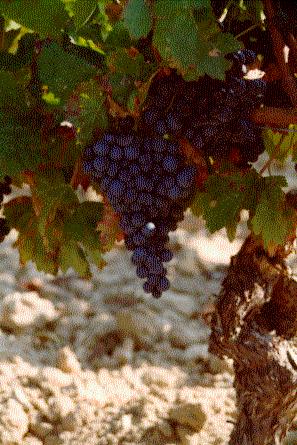
The Languedoc: Corbieres and Pic-St-Loup
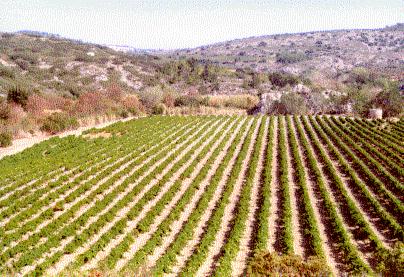
A vineyard at Chateau de Lastours, Corbieres
At the outset of this trip, knowing that the number of days spent doing "wine stuff" would be rationed, I decided to concentrate look at some of the less well known wine areas of France. Rather than follow the crowds to Bordeaux, Burgundy, Alsace et al, I thought it would be fun to visit areas normally associated with plonk but where quality-minded producers are beginning to emerge. Two areas in the Languedoc, Corbieres and Pic St Loup fitted this bill perfectly. Blessed with old vines, great weather, good soils and a host of interesting grape varieties, growers in these regions have often squandered their resources through high yields and clumsy winemaking. In recent years, though, many have realised that people will pay more for better wine, and with more care in the vineyard and improved technique in the winery there are now some excellent wines at very fair prices being made in these regions. Added to this, the hilly Corbieres region boasts some of the most dramatically attractive and unspoiled countryside in the South of France.
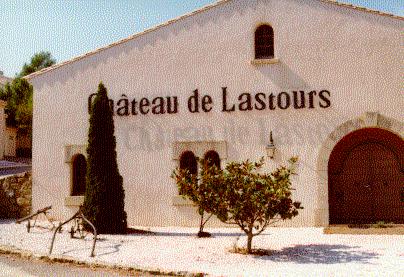
Chateau de Lastours
This Corbieres property enjoys a better
reputation than most, and having enjoyed the Cuvee Simone Descamps before, I was looking
forward to visiting the estate itself. Located just out of the town of Portel des
Corbieres, it was actually quite hard to find, nestled in the hillside off a long and
dusty track. The further difficulties encountered trying to find the tasting room were
more than made up for by the friendliness of the lady pouring the wines, which were
uniformly good:
Blanc de blanc 1997 From an appelation best
known for its red wines, this white, a 50/50 blend of Malvoise and Grenache blanc, was an
absolute revelation and the star performer of the tasting. Fresh, with floral and spicy
notes, it was full of interest and very tasty.**
Cuvee Simone Descamps 1994 50% Carignan, 35% Grenache, 15% Syrah. Warm slightly
earthy bouquet, medium bodied, good tannins. A solid performer.
Cuvee Simone Descamps Fut de Chene 1994 This one has seen some wood: 12 months new
oak in fact. It is deeper in colour, with a distinctive earthy nose, noticeable oak and
drying tannins underpinning the rich fruit. Good.
The first two wines were priced around 40 ff, the third about 50 ff. I bought some of the first two.
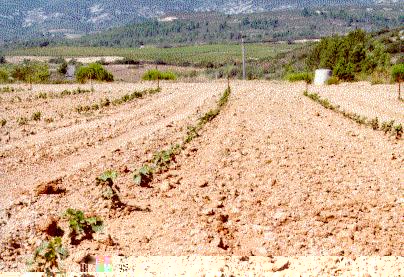
Young vines recently planted at Chateau de Lastours Chateau La Voulte Gasparets
Another wine I had encountered in the UK. The address given in La Guide Hachette was in Boutenac, a tiny town in the north of the appelation. On arrival, I was quite surprised to find that I had to ring on what appeared to be the doorbell of a house. I did this and waited. Then an old man appeared and shouted out something in French, before shuffling off. Shortly after, a young girl of about 20 appeared and led me off into the Cave, which was at the bottom of the garden. Despite my initial misgivings, she knew about wine, was friendly and was quick on the pour. Three wines are produced here, two red and one white (already sold out). I tried just the 1996 reserve cuvee (60% Carignane, 30% Grenache, 10% Syrah, aged in barrels a quarter of which are new). Full coloured, this is a big wine with rustic flavours. At 37 ff this is a great value and should improve for a few years in bottle.
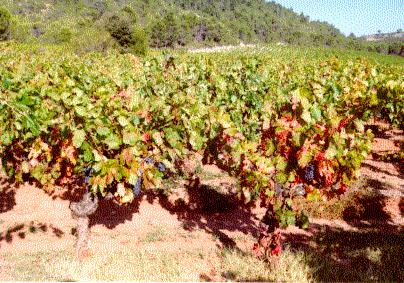
Typical vineyard scene, Corbieres
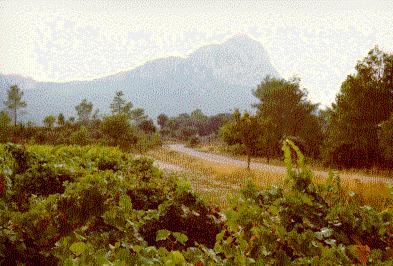
T
he Pic St Loup (the shadow in the photo above) is a large rock formation just out of the town of St Martin de Londres, 20 km or so north of Montpellier. Around the Pic are dotted a number of wineries, many of whom are making good, full flavoured reds (often Syrah-based) at very good prices. From these estates, a few superstars are emerging such as Domaine L'Hortus. We drove past the new wood-built winery, but didn't have a chance to visit. It'll have to wait for next time. For an in-depth review of the wines from this region, see my article on the features page.